Strategies for Business Integration: Report and Recommendations
VerifiedAdded on 2020/03/23
|10
|2597
|139
Report
AI Summary
This report delves into the critical aspects of organizational strategies and business integration, examining a company's performance and strategic approaches. It explores various facets, including strategic leadership, business ethics, functional level strategy, marketing, economic aspects, global strategy, business level strategies, business information systems, and corporate level strategy. The report highlights the importance of leadership, ethical practices, and effective strategies for achieving competitive advantage and profitability. It discusses the application of concepts from various scholars and peregrine modules, emphasizing the significance of marketing, supply chain management, and economic considerations. The report also covers globalization, business level strategies, and the role of information systems. Finally, it offers recommendations for improvement, particularly in marketing and the utilization of current technologies, and concludes that effective organizational strategies are essential for business success and achieving set goals.
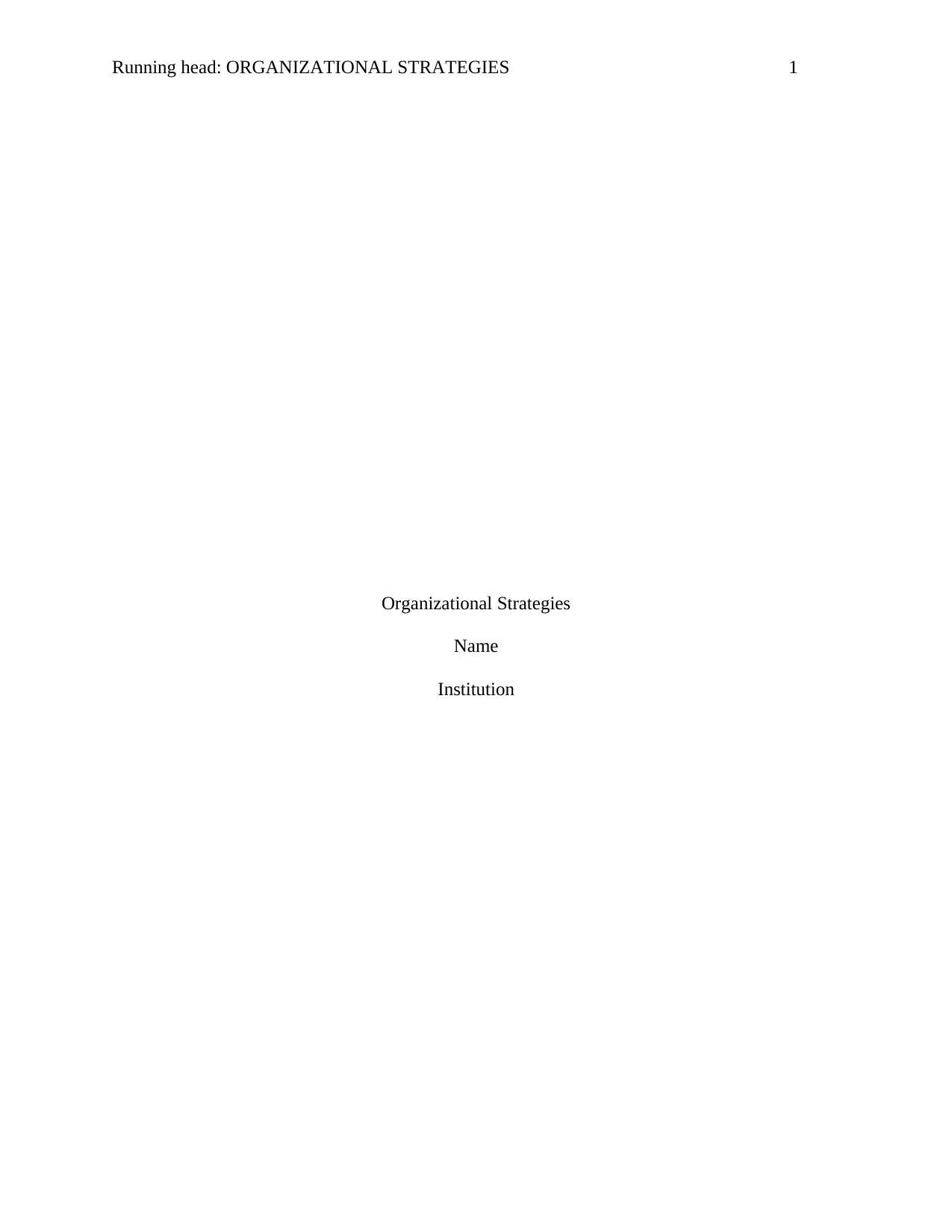
Running head: ORGANIZATIONAL STRATEGIES 1
Organizational Strategies
Name
Institution
Organizational Strategies
Name
Institution
Paraphrase This Document
Need a fresh take? Get an instant paraphrase of this document with our AI Paraphraser
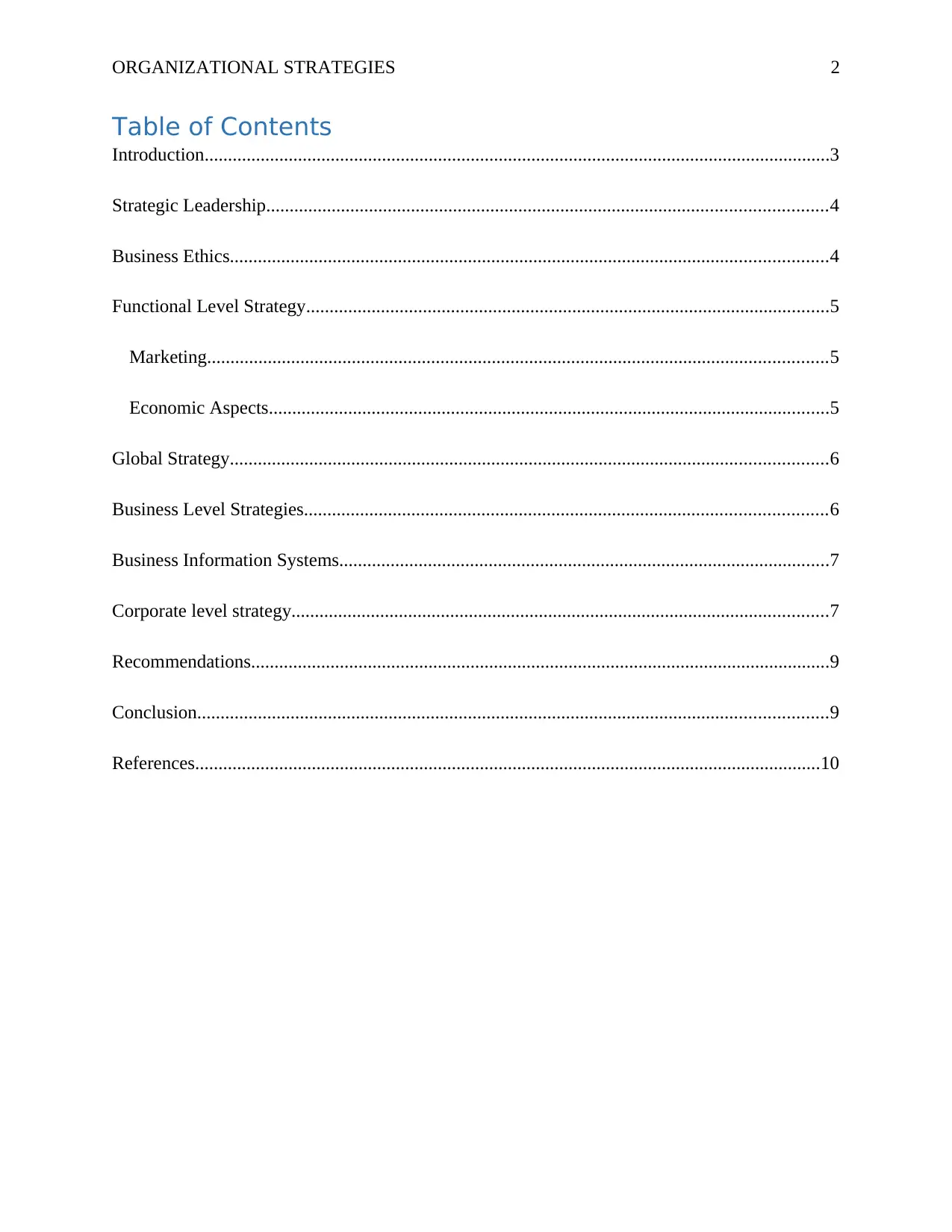
ORGANIZATIONAL STRATEGIES 2
Table of Contents
Introduction......................................................................................................................................3
Strategic Leadership........................................................................................................................4
Business Ethics................................................................................................................................4
Functional Level Strategy................................................................................................................5
Marketing.....................................................................................................................................5
Economic Aspects........................................................................................................................5
Global Strategy................................................................................................................................6
Business Level Strategies................................................................................................................6
Business Information Systems.........................................................................................................7
Corporate level strategy...................................................................................................................7
Recommendations............................................................................................................................9
Conclusion.......................................................................................................................................9
References......................................................................................................................................10
Table of Contents
Introduction......................................................................................................................................3
Strategic Leadership........................................................................................................................4
Business Ethics................................................................................................................................4
Functional Level Strategy................................................................................................................5
Marketing.....................................................................................................................................5
Economic Aspects........................................................................................................................5
Global Strategy................................................................................................................................6
Business Level Strategies................................................................................................................6
Business Information Systems.........................................................................................................7
Corporate level strategy...................................................................................................................7
Recommendations............................................................................................................................9
Conclusion.......................................................................................................................................9
References......................................................................................................................................10
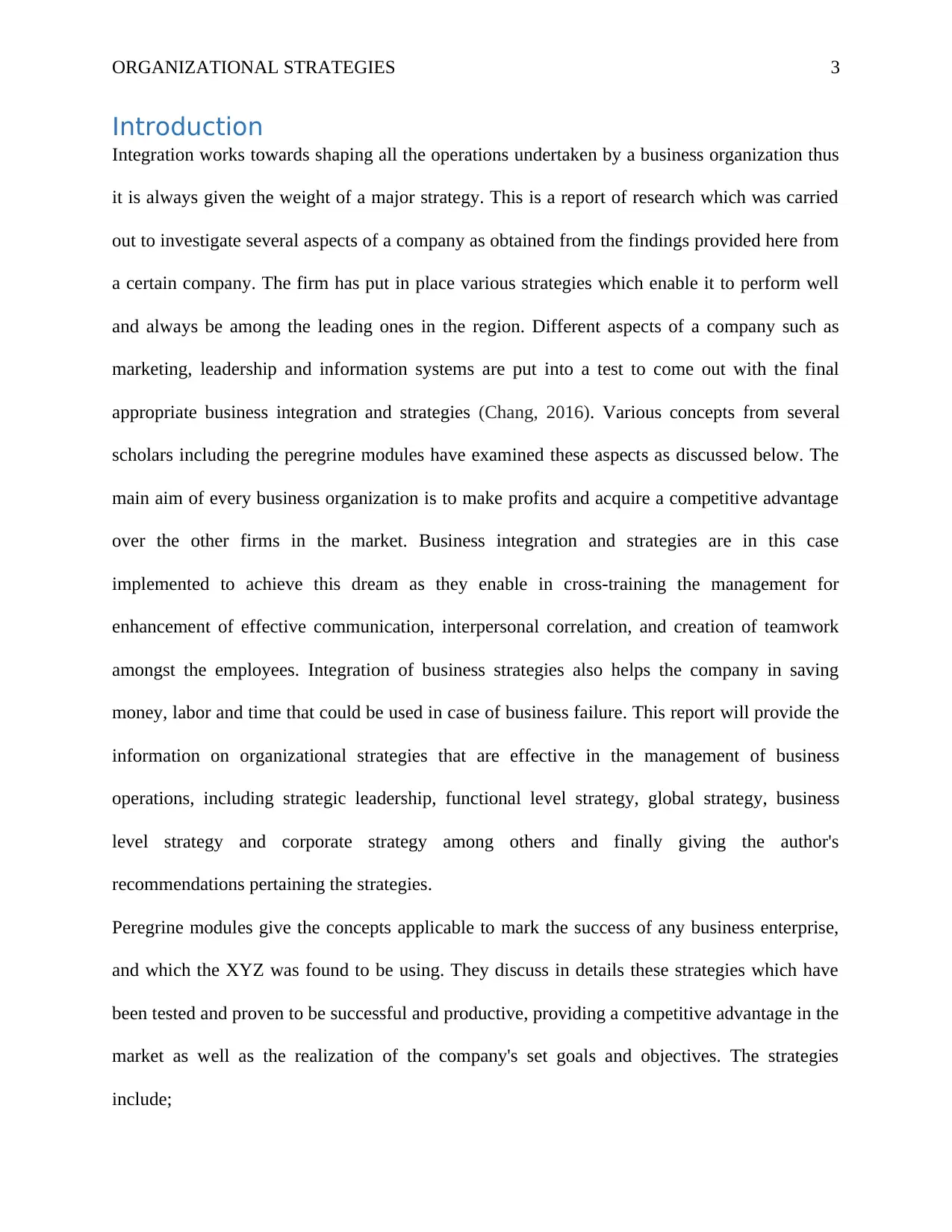
ORGANIZATIONAL STRATEGIES 3
Introduction
Integration works towards shaping all the operations undertaken by a business organization thus
it is always given the weight of a major strategy. This is a report of research which was carried
out to investigate several aspects of a company as obtained from the findings provided here from
a certain company. The firm has put in place various strategies which enable it to perform well
and always be among the leading ones in the region. Different aspects of a company such as
marketing, leadership and information systems are put into a test to come out with the final
appropriate business integration and strategies (Chang, 2016). Various concepts from several
scholars including the peregrine modules have examined these aspects as discussed below. The
main aim of every business organization is to make profits and acquire a competitive advantage
over the other firms in the market. Business integration and strategies are in this case
implemented to achieve this dream as they enable in cross-training the management for
enhancement of effective communication, interpersonal correlation, and creation of teamwork
amongst the employees. Integration of business strategies also helps the company in saving
money, labor and time that could be used in case of business failure. This report will provide the
information on organizational strategies that are effective in the management of business
operations, including strategic leadership, functional level strategy, global strategy, business
level strategy and corporate strategy among others and finally giving the author's
recommendations pertaining the strategies.
Peregrine modules give the concepts applicable to mark the success of any business enterprise,
and which the XYZ was found to be using. They discuss in details these strategies which have
been tested and proven to be successful and productive, providing a competitive advantage in the
market as well as the realization of the company's set goals and objectives. The strategies
include;
Introduction
Integration works towards shaping all the operations undertaken by a business organization thus
it is always given the weight of a major strategy. This is a report of research which was carried
out to investigate several aspects of a company as obtained from the findings provided here from
a certain company. The firm has put in place various strategies which enable it to perform well
and always be among the leading ones in the region. Different aspects of a company such as
marketing, leadership and information systems are put into a test to come out with the final
appropriate business integration and strategies (Chang, 2016). Various concepts from several
scholars including the peregrine modules have examined these aspects as discussed below. The
main aim of every business organization is to make profits and acquire a competitive advantage
over the other firms in the market. Business integration and strategies are in this case
implemented to achieve this dream as they enable in cross-training the management for
enhancement of effective communication, interpersonal correlation, and creation of teamwork
amongst the employees. Integration of business strategies also helps the company in saving
money, labor and time that could be used in case of business failure. This report will provide the
information on organizational strategies that are effective in the management of business
operations, including strategic leadership, functional level strategy, global strategy, business
level strategy and corporate strategy among others and finally giving the author's
recommendations pertaining the strategies.
Peregrine modules give the concepts applicable to mark the success of any business enterprise,
and which the XYZ was found to be using. They discuss in details these strategies which have
been tested and proven to be successful and productive, providing a competitive advantage in the
market as well as the realization of the company's set goals and objectives. The strategies
include;
⊘ This is a preview!⊘
Do you want full access?
Subscribe today to unlock all pages.

Trusted by 1+ million students worldwide
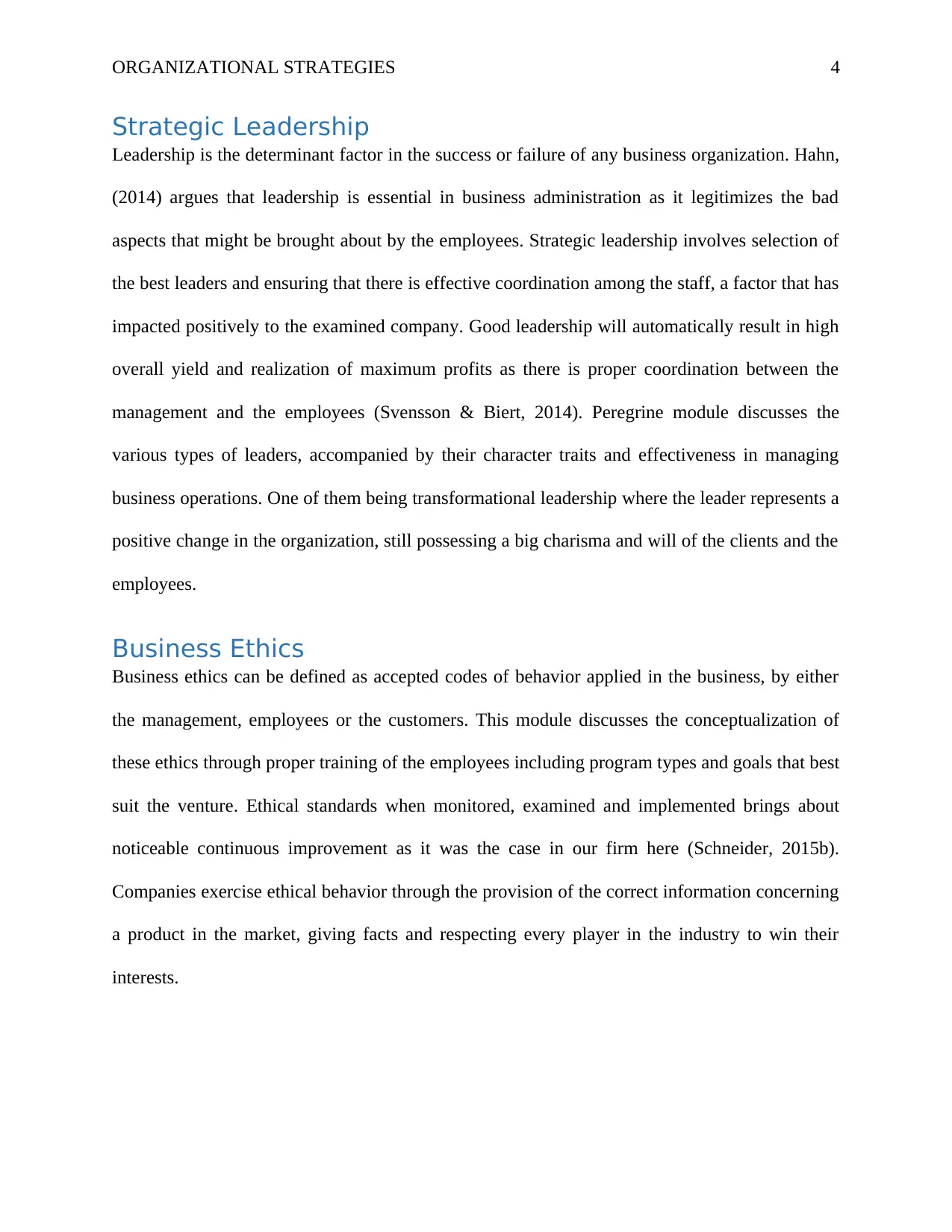
ORGANIZATIONAL STRATEGIES 4
Strategic Leadership
Leadership is the determinant factor in the success or failure of any business organization. Hahn,
(2014) argues that leadership is essential in business administration as it legitimizes the bad
aspects that might be brought about by the employees. Strategic leadership involves selection of
the best leaders and ensuring that there is effective coordination among the staff, a factor that has
impacted positively to the examined company. Good leadership will automatically result in high
overall yield and realization of maximum profits as there is proper coordination between the
management and the employees (Svensson & Biert, 2014). Peregrine module discusses the
various types of leaders, accompanied by their character traits and effectiveness in managing
business operations. One of them being transformational leadership where the leader represents a
positive change in the organization, still possessing a big charisma and will of the clients and the
employees.
Business Ethics
Business ethics can be defined as accepted codes of behavior applied in the business, by either
the management, employees or the customers. This module discusses the conceptualization of
these ethics through proper training of the employees including program types and goals that best
suit the venture. Ethical standards when monitored, examined and implemented brings about
noticeable continuous improvement as it was the case in our firm here (Schneider, 2015b).
Companies exercise ethical behavior through the provision of the correct information concerning
a product in the market, giving facts and respecting every player in the industry to win their
interests.
Strategic Leadership
Leadership is the determinant factor in the success or failure of any business organization. Hahn,
(2014) argues that leadership is essential in business administration as it legitimizes the bad
aspects that might be brought about by the employees. Strategic leadership involves selection of
the best leaders and ensuring that there is effective coordination among the staff, a factor that has
impacted positively to the examined company. Good leadership will automatically result in high
overall yield and realization of maximum profits as there is proper coordination between the
management and the employees (Svensson & Biert, 2014). Peregrine module discusses the
various types of leaders, accompanied by their character traits and effectiveness in managing
business operations. One of them being transformational leadership where the leader represents a
positive change in the organization, still possessing a big charisma and will of the clients and the
employees.
Business Ethics
Business ethics can be defined as accepted codes of behavior applied in the business, by either
the management, employees or the customers. This module discusses the conceptualization of
these ethics through proper training of the employees including program types and goals that best
suit the venture. Ethical standards when monitored, examined and implemented brings about
noticeable continuous improvement as it was the case in our firm here (Schneider, 2015b).
Companies exercise ethical behavior through the provision of the correct information concerning
a product in the market, giving facts and respecting every player in the industry to win their
interests.
Paraphrase This Document
Need a fresh take? Get an instant paraphrase of this document with our AI Paraphraser
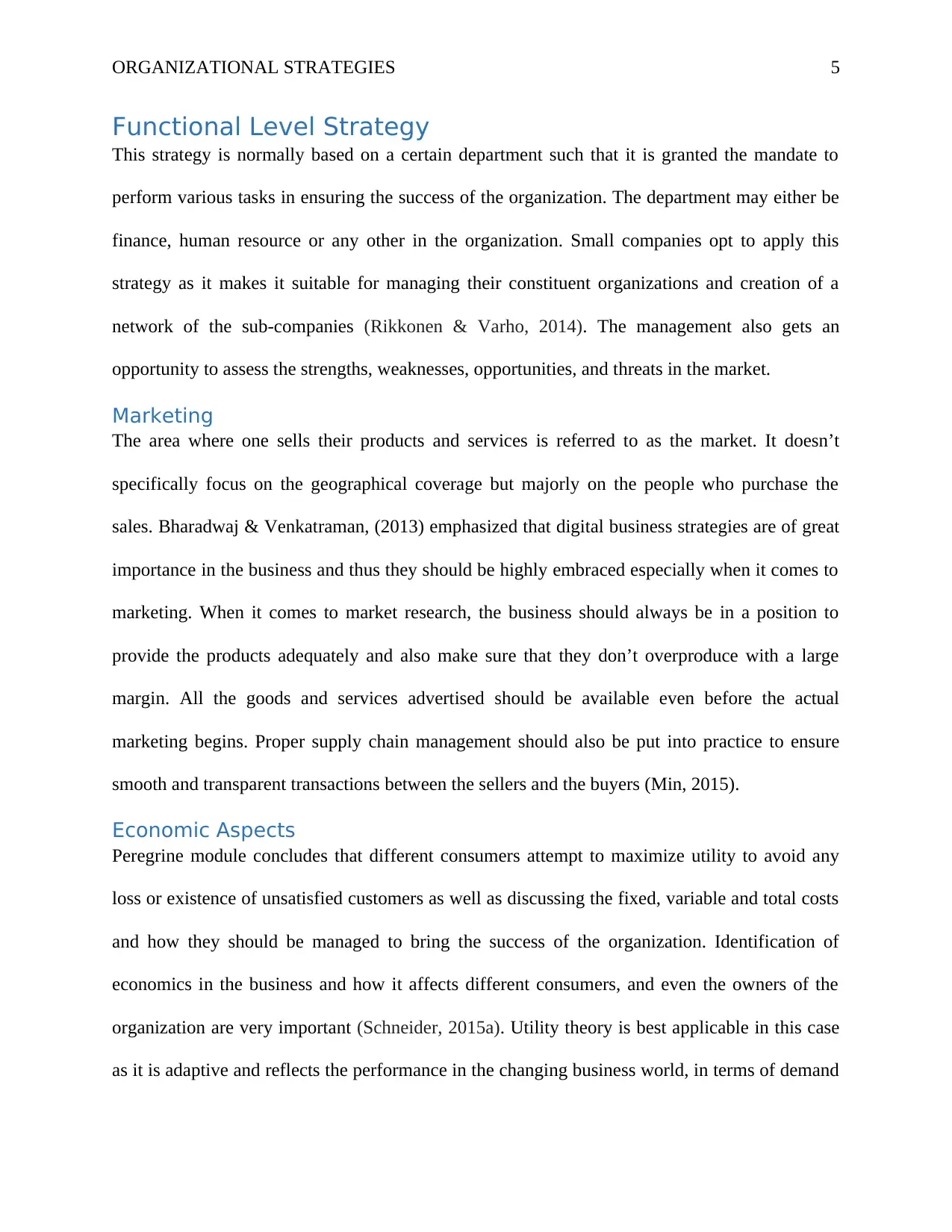
ORGANIZATIONAL STRATEGIES 5
Functional Level Strategy
This strategy is normally based on a certain department such that it is granted the mandate to
perform various tasks in ensuring the success of the organization. The department may either be
finance, human resource or any other in the organization. Small companies opt to apply this
strategy as it makes it suitable for managing their constituent organizations and creation of a
network of the sub-companies (Rikkonen & Varho, 2014). The management also gets an
opportunity to assess the strengths, weaknesses, opportunities, and threats in the market.
Marketing
The area where one sells their products and services is referred to as the market. It doesn’t
specifically focus on the geographical coverage but majorly on the people who purchase the
sales. Bharadwaj & Venkatraman, (2013) emphasized that digital business strategies are of great
importance in the business and thus they should be highly embraced especially when it comes to
marketing. When it comes to market research, the business should always be in a position to
provide the products adequately and also make sure that they don’t overproduce with a large
margin. All the goods and services advertised should be available even before the actual
marketing begins. Proper supply chain management should also be put into practice to ensure
smooth and transparent transactions between the sellers and the buyers (Min, 2015).
Economic Aspects
Peregrine module concludes that different consumers attempt to maximize utility to avoid any
loss or existence of unsatisfied customers as well as discussing the fixed, variable and total costs
and how they should be managed to bring the success of the organization. Identification of
economics in the business and how it affects different consumers, and even the owners of the
organization are very important (Schneider, 2015a). Utility theory is best applicable in this case
as it is adaptive and reflects the performance in the changing business world, in terms of demand
Functional Level Strategy
This strategy is normally based on a certain department such that it is granted the mandate to
perform various tasks in ensuring the success of the organization. The department may either be
finance, human resource or any other in the organization. Small companies opt to apply this
strategy as it makes it suitable for managing their constituent organizations and creation of a
network of the sub-companies (Rikkonen & Varho, 2014). The management also gets an
opportunity to assess the strengths, weaknesses, opportunities, and threats in the market.
Marketing
The area where one sells their products and services is referred to as the market. It doesn’t
specifically focus on the geographical coverage but majorly on the people who purchase the
sales. Bharadwaj & Venkatraman, (2013) emphasized that digital business strategies are of great
importance in the business and thus they should be highly embraced especially when it comes to
marketing. When it comes to market research, the business should always be in a position to
provide the products adequately and also make sure that they don’t overproduce with a large
margin. All the goods and services advertised should be available even before the actual
marketing begins. Proper supply chain management should also be put into practice to ensure
smooth and transparent transactions between the sellers and the buyers (Min, 2015).
Economic Aspects
Peregrine module concludes that different consumers attempt to maximize utility to avoid any
loss or existence of unsatisfied customers as well as discussing the fixed, variable and total costs
and how they should be managed to bring the success of the organization. Identification of
economics in the business and how it affects different consumers, and even the owners of the
organization are very important (Schneider, 2015a). Utility theory is best applicable in this case
as it is adaptive and reflects the performance in the changing business world, in terms of demand
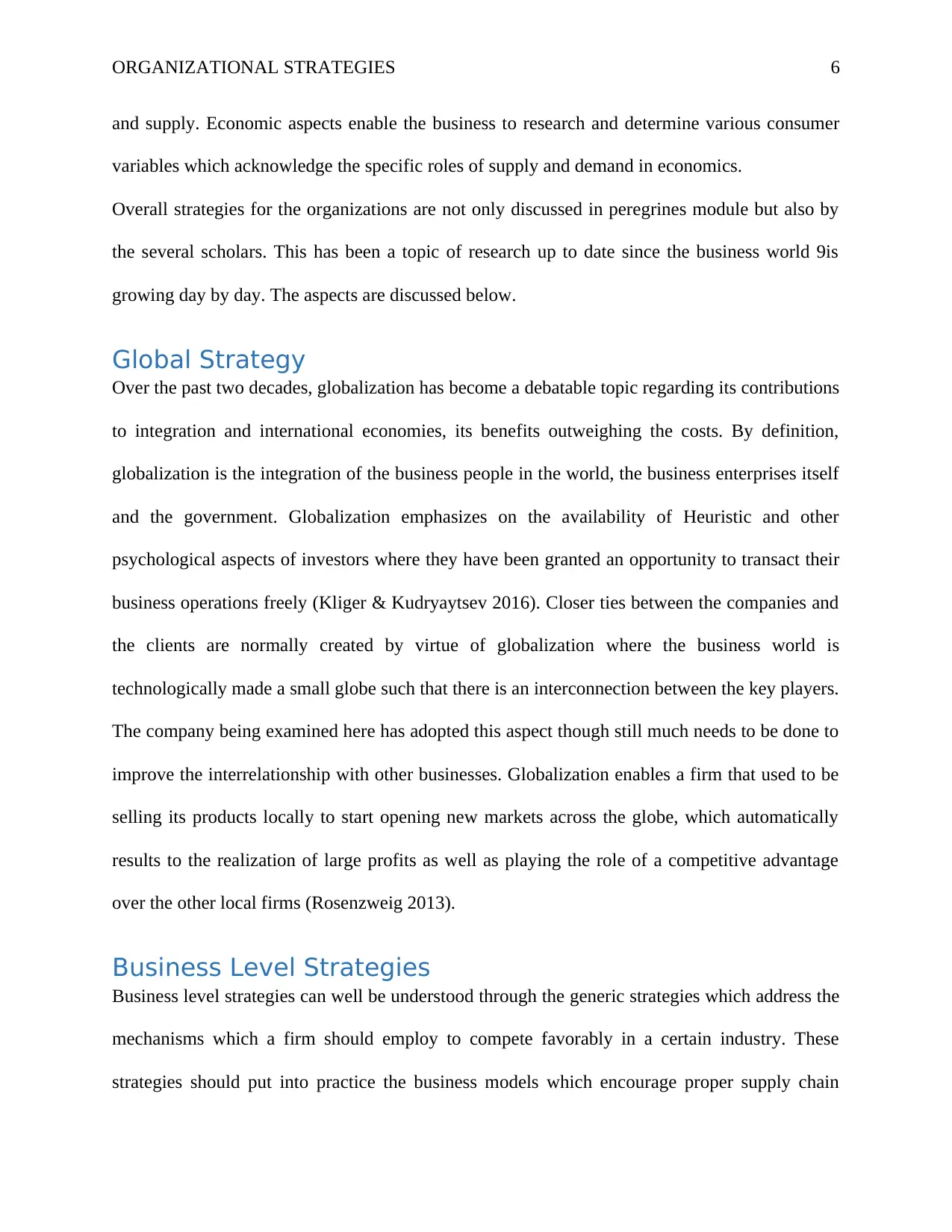
ORGANIZATIONAL STRATEGIES 6
and supply. Economic aspects enable the business to research and determine various consumer
variables which acknowledge the specific roles of supply and demand in economics.
Overall strategies for the organizations are not only discussed in peregrines module but also by
the several scholars. This has been a topic of research up to date since the business world 9is
growing day by day. The aspects are discussed below.
Global Strategy
Over the past two decades, globalization has become a debatable topic regarding its contributions
to integration and international economies, its benefits outweighing the costs. By definition,
globalization is the integration of the business people in the world, the business enterprises itself
and the government. Globalization emphasizes on the availability of Heuristic and other
psychological aspects of investors where they have been granted an opportunity to transact their
business operations freely (Kliger & Kudryaytsev 2016). Closer ties between the companies and
the clients are normally created by virtue of globalization where the business world is
technologically made a small globe such that there is an interconnection between the key players.
The company being examined here has adopted this aspect though still much needs to be done to
improve the interrelationship with other businesses. Globalization enables a firm that used to be
selling its products locally to start opening new markets across the globe, which automatically
results to the realization of large profits as well as playing the role of a competitive advantage
over the other local firms (Rosenzweig 2013).
Business Level Strategies
Business level strategies can well be understood through the generic strategies which address the
mechanisms which a firm should employ to compete favorably in a certain industry. These
strategies should put into practice the business models which encourage proper supply chain
and supply. Economic aspects enable the business to research and determine various consumer
variables which acknowledge the specific roles of supply and demand in economics.
Overall strategies for the organizations are not only discussed in peregrines module but also by
the several scholars. This has been a topic of research up to date since the business world 9is
growing day by day. The aspects are discussed below.
Global Strategy
Over the past two decades, globalization has become a debatable topic regarding its contributions
to integration and international economies, its benefits outweighing the costs. By definition,
globalization is the integration of the business people in the world, the business enterprises itself
and the government. Globalization emphasizes on the availability of Heuristic and other
psychological aspects of investors where they have been granted an opportunity to transact their
business operations freely (Kliger & Kudryaytsev 2016). Closer ties between the companies and
the clients are normally created by virtue of globalization where the business world is
technologically made a small globe such that there is an interconnection between the key players.
The company being examined here has adopted this aspect though still much needs to be done to
improve the interrelationship with other businesses. Globalization enables a firm that used to be
selling its products locally to start opening new markets across the globe, which automatically
results to the realization of large profits as well as playing the role of a competitive advantage
over the other local firms (Rosenzweig 2013).
Business Level Strategies
Business level strategies can well be understood through the generic strategies which address the
mechanisms which a firm should employ to compete favorably in a certain industry. These
strategies should put into practice the business models which encourage proper supply chain
⊘ This is a preview!⊘
Do you want full access?
Subscribe today to unlock all pages.

Trusted by 1+ million students worldwide
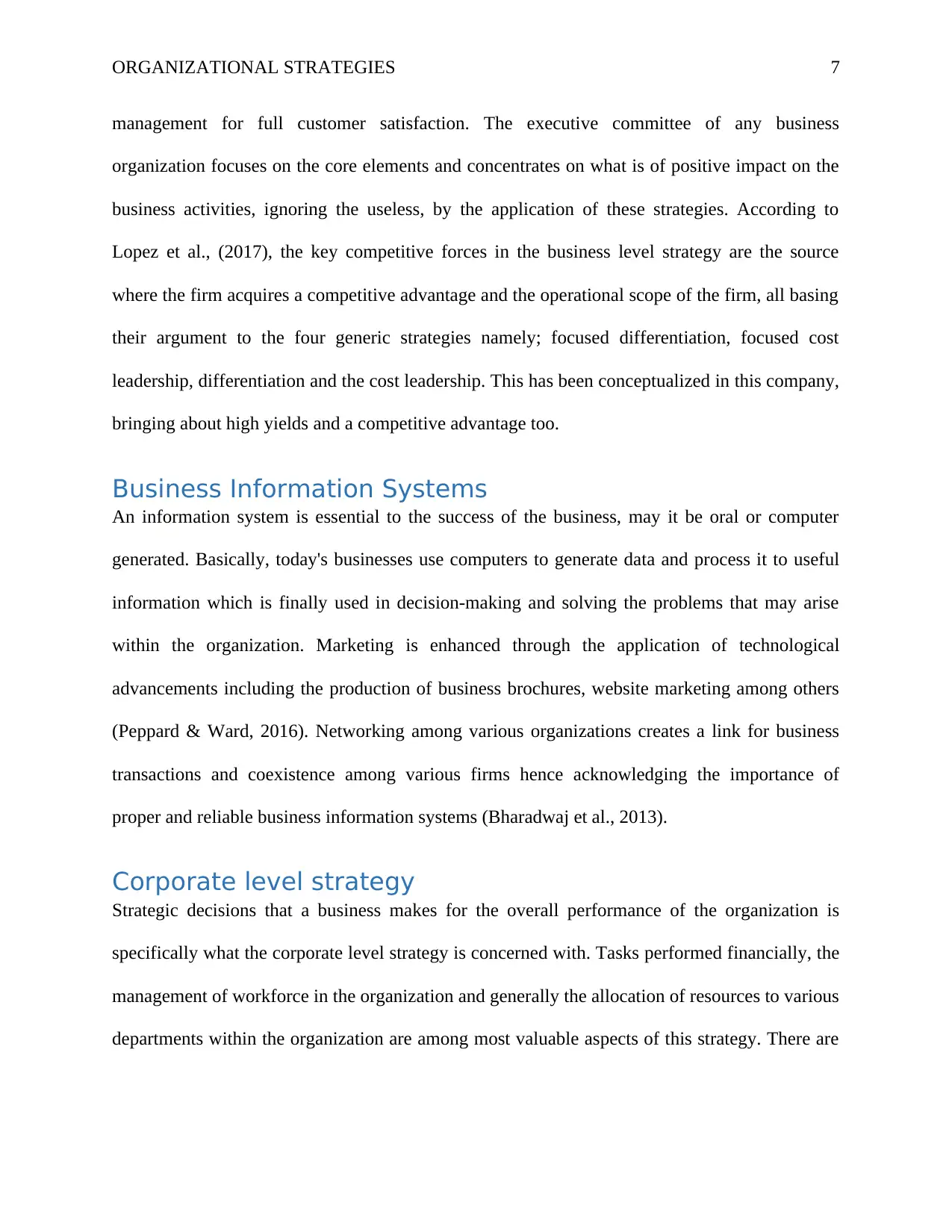
ORGANIZATIONAL STRATEGIES 7
management for full customer satisfaction. The executive committee of any business
organization focuses on the core elements and concentrates on what is of positive impact on the
business activities, ignoring the useless, by the application of these strategies. According to
Lopez et al., (2017), the key competitive forces in the business level strategy are the source
where the firm acquires a competitive advantage and the operational scope of the firm, all basing
their argument to the four generic strategies namely; focused differentiation, focused cost
leadership, differentiation and the cost leadership. This has been conceptualized in this company,
bringing about high yields and a competitive advantage too.
Business Information Systems
An information system is essential to the success of the business, may it be oral or computer
generated. Basically, today's businesses use computers to generate data and process it to useful
information which is finally used in decision-making and solving the problems that may arise
within the organization. Marketing is enhanced through the application of technological
advancements including the production of business brochures, website marketing among others
(Peppard & Ward, 2016). Networking among various organizations creates a link for business
transactions and coexistence among various firms hence acknowledging the importance of
proper and reliable business information systems (Bharadwaj et al., 2013).
Corporate level strategy
Strategic decisions that a business makes for the overall performance of the organization is
specifically what the corporate level strategy is concerned with. Tasks performed financially, the
management of workforce in the organization and generally the allocation of resources to various
departments within the organization are among most valuable aspects of this strategy. There are
management for full customer satisfaction. The executive committee of any business
organization focuses on the core elements and concentrates on what is of positive impact on the
business activities, ignoring the useless, by the application of these strategies. According to
Lopez et al., (2017), the key competitive forces in the business level strategy are the source
where the firm acquires a competitive advantage and the operational scope of the firm, all basing
their argument to the four generic strategies namely; focused differentiation, focused cost
leadership, differentiation and the cost leadership. This has been conceptualized in this company,
bringing about high yields and a competitive advantage too.
Business Information Systems
An information system is essential to the success of the business, may it be oral or computer
generated. Basically, today's businesses use computers to generate data and process it to useful
information which is finally used in decision-making and solving the problems that may arise
within the organization. Marketing is enhanced through the application of technological
advancements including the production of business brochures, website marketing among others
(Peppard & Ward, 2016). Networking among various organizations creates a link for business
transactions and coexistence among various firms hence acknowledging the importance of
proper and reliable business information systems (Bharadwaj et al., 2013).
Corporate level strategy
Strategic decisions that a business makes for the overall performance of the organization is
specifically what the corporate level strategy is concerned with. Tasks performed financially, the
management of workforce in the organization and generally the allocation of resources to various
departments within the organization are among most valuable aspects of this strategy. There are
Paraphrase This Document
Need a fresh take? Get an instant paraphrase of this document with our AI Paraphraser
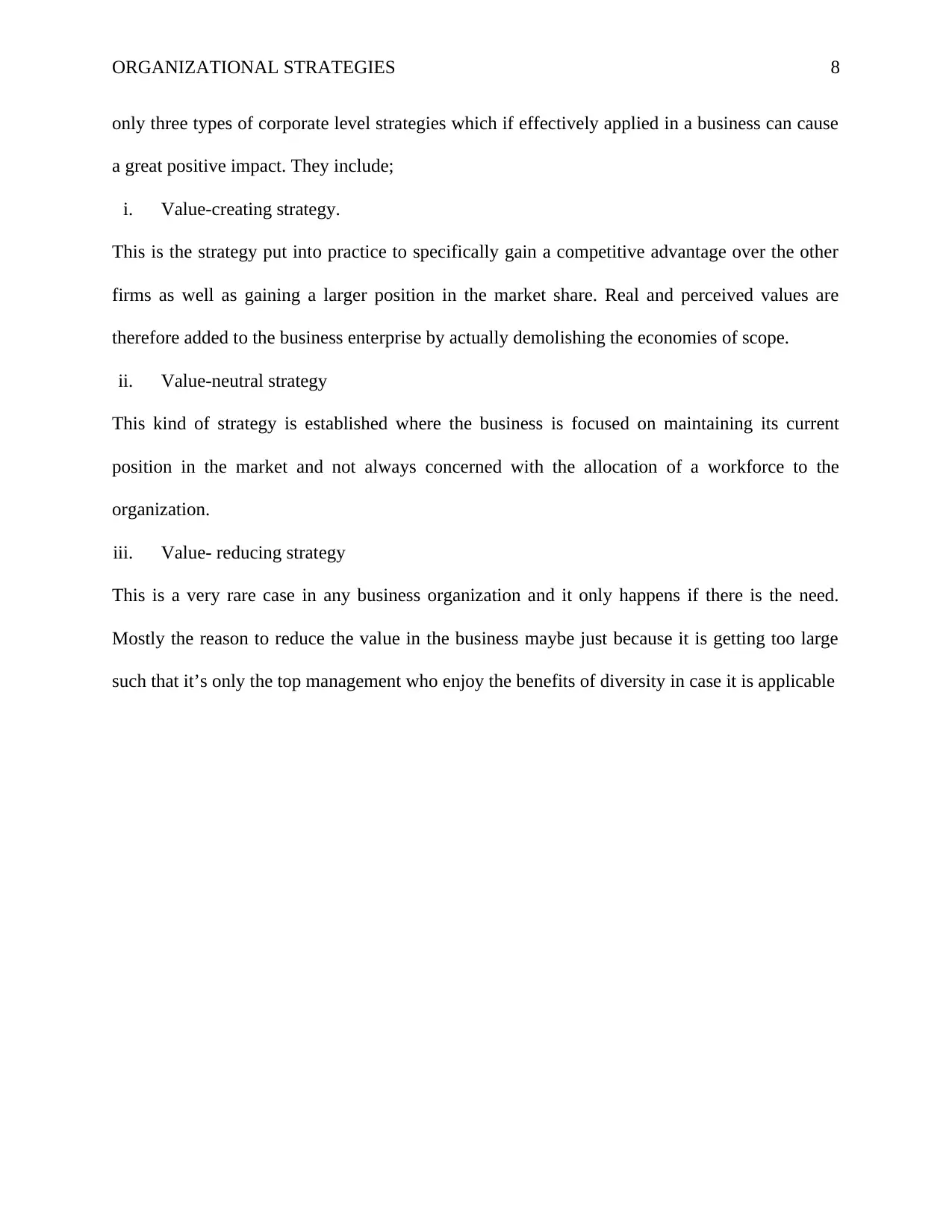
ORGANIZATIONAL STRATEGIES 8
only three types of corporate level strategies which if effectively applied in a business can cause
a great positive impact. They include;
i. Value-creating strategy.
This is the strategy put into practice to specifically gain a competitive advantage over the other
firms as well as gaining a larger position in the market share. Real and perceived values are
therefore added to the business enterprise by actually demolishing the economies of scope.
ii. Value-neutral strategy
This kind of strategy is established where the business is focused on maintaining its current
position in the market and not always concerned with the allocation of a workforce to the
organization.
iii. Value- reducing strategy
This is a very rare case in any business organization and it only happens if there is the need.
Mostly the reason to reduce the value in the business maybe just because it is getting too large
such that it’s only the top management who enjoy the benefits of diversity in case it is applicable
only three types of corporate level strategies which if effectively applied in a business can cause
a great positive impact. They include;
i. Value-creating strategy.
This is the strategy put into practice to specifically gain a competitive advantage over the other
firms as well as gaining a larger position in the market share. Real and perceived values are
therefore added to the business enterprise by actually demolishing the economies of scope.
ii. Value-neutral strategy
This kind of strategy is established where the business is focused on maintaining its current
position in the market and not always concerned with the allocation of a workforce to the
organization.
iii. Value- reducing strategy
This is a very rare case in any business organization and it only happens if there is the need.
Mostly the reason to reduce the value in the business maybe just because it is getting too large
such that it’s only the top management who enjoy the benefits of diversity in case it is applicable
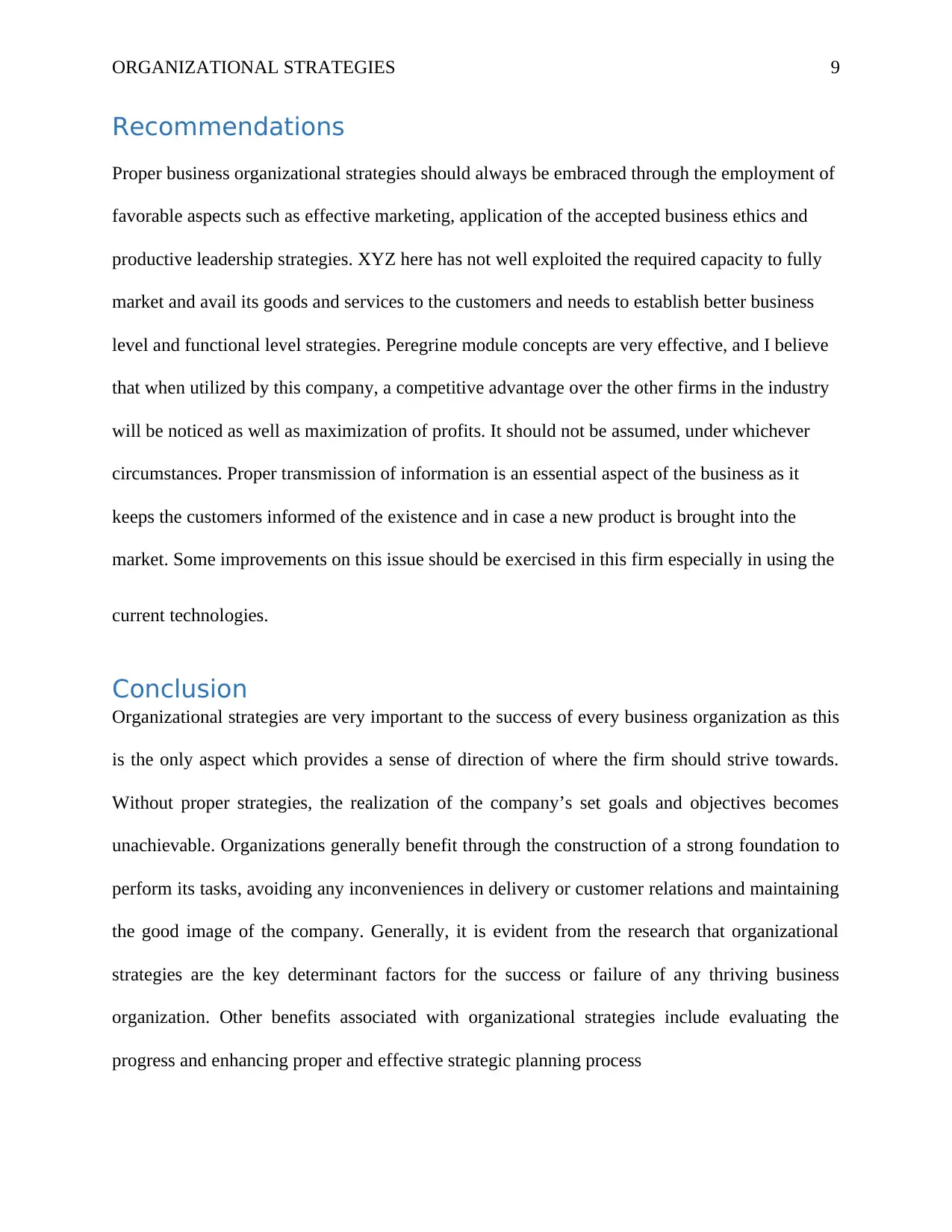
ORGANIZATIONAL STRATEGIES 9
Recommendations
Proper business organizational strategies should always be embraced through the employment of
favorable aspects such as effective marketing, application of the accepted business ethics and
productive leadership strategies. XYZ here has not well exploited the required capacity to fully
market and avail its goods and services to the customers and needs to establish better business
level and functional level strategies. Peregrine module concepts are very effective, and I believe
that when utilized by this company, a competitive advantage over the other firms in the industry
will be noticed as well as maximization of profits. It should not be assumed, under whichever
circumstances. Proper transmission of information is an essential aspect of the business as it
keeps the customers informed of the existence and in case a new product is brought into the
market. Some improvements on this issue should be exercised in this firm especially in using the
current technologies.
Conclusion
Organizational strategies are very important to the success of every business organization as this
is the only aspect which provides a sense of direction of where the firm should strive towards.
Without proper strategies, the realization of the company’s set goals and objectives becomes
unachievable. Organizations generally benefit through the construction of a strong foundation to
perform its tasks, avoiding any inconveniences in delivery or customer relations and maintaining
the good image of the company. Generally, it is evident from the research that organizational
strategies are the key determinant factors for the success or failure of any thriving business
organization. Other benefits associated with organizational strategies include evaluating the
progress and enhancing proper and effective strategic planning process
Recommendations
Proper business organizational strategies should always be embraced through the employment of
favorable aspects such as effective marketing, application of the accepted business ethics and
productive leadership strategies. XYZ here has not well exploited the required capacity to fully
market and avail its goods and services to the customers and needs to establish better business
level and functional level strategies. Peregrine module concepts are very effective, and I believe
that when utilized by this company, a competitive advantage over the other firms in the industry
will be noticed as well as maximization of profits. It should not be assumed, under whichever
circumstances. Proper transmission of information is an essential aspect of the business as it
keeps the customers informed of the existence and in case a new product is brought into the
market. Some improvements on this issue should be exercised in this firm especially in using the
current technologies.
Conclusion
Organizational strategies are very important to the success of every business organization as this
is the only aspect which provides a sense of direction of where the firm should strive towards.
Without proper strategies, the realization of the company’s set goals and objectives becomes
unachievable. Organizations generally benefit through the construction of a strong foundation to
perform its tasks, avoiding any inconveniences in delivery or customer relations and maintaining
the good image of the company. Generally, it is evident from the research that organizational
strategies are the key determinant factors for the success or failure of any thriving business
organization. Other benefits associated with organizational strategies include evaluating the
progress and enhancing proper and effective strategic planning process
⊘ This is a preview!⊘
Do you want full access?
Subscribe today to unlock all pages.

Trusted by 1+ million students worldwide
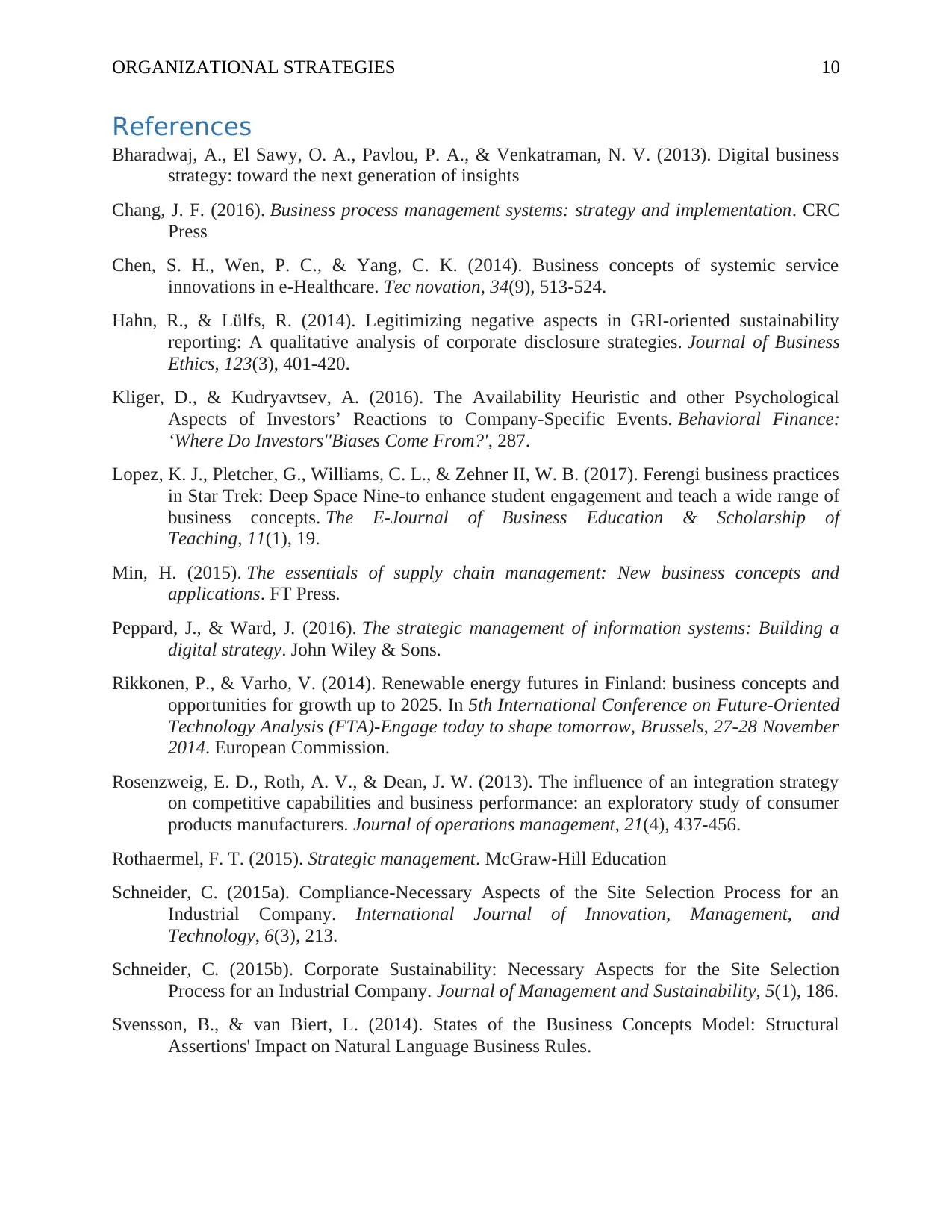
ORGANIZATIONAL STRATEGIES 10
References
Bharadwaj, A., El Sawy, O. A., Pavlou, P. A., & Venkatraman, N. V. (2013). Digital business
strategy: toward the next generation of insights
Chang, J. F. (2016). Business process management systems: strategy and implementation. CRC
Press
Chen, S. H., Wen, P. C., & Yang, C. K. (2014). Business concepts of systemic service
innovations in e-Healthcare. Tec novation, 34(9), 513-524.
Hahn, R., & Lülfs, R. (2014). Legitimizing negative aspects in GRI-oriented sustainability
reporting: A qualitative analysis of corporate disclosure strategies. Journal of Business
Ethics, 123(3), 401-420.
Kliger, D., & Kudryavtsev, A. (2016). The Availability Heuristic and other Psychological
Aspects of Investors’ Reactions to Company-Specific Events. Behavioral Finance:
‘Where Do Investors''Biases Come From?', 287.
Lopez, K. J., Pletcher, G., Williams, C. L., & Zehner II, W. B. (2017). Ferengi business practices
in Star Trek: Deep Space Nine-to enhance student engagement and teach a wide range of
business concepts. The E-Journal of Business Education & Scholarship of
Teaching, 11(1), 19.
Min, H. (2015). The essentials of supply chain management: New business concepts and
applications. FT Press.
Peppard, J., & Ward, J. (2016). The strategic management of information systems: Building a
digital strategy. John Wiley & Sons.
Rikkonen, P., & Varho, V. (2014). Renewable energy futures in Finland: business concepts and
opportunities for growth up to 2025. In 5th International Conference on Future-Oriented
Technology Analysis (FTA)-Engage today to shape tomorrow, Brussels, 27-28 November
2014. European Commission.
Rosenzweig, E. D., Roth, A. V., & Dean, J. W. (2013). The influence of an integration strategy
on competitive capabilities and business performance: an exploratory study of consumer
products manufacturers. Journal of operations management, 21(4), 437-456.
Rothaermel, F. T. (2015). Strategic management. McGraw-Hill Education
Schneider, C. (2015a). Compliance-Necessary Aspects of the Site Selection Process for an
Industrial Company. International Journal of Innovation, Management, and
Technology, 6(3), 213.
Schneider, C. (2015b). Corporate Sustainability: Necessary Aspects for the Site Selection
Process for an Industrial Company. Journal of Management and Sustainability, 5(1), 186.
Svensson, B., & van Biert, L. (2014). States of the Business Concepts Model: Structural
Assertions' Impact on Natural Language Business Rules.
References
Bharadwaj, A., El Sawy, O. A., Pavlou, P. A., & Venkatraman, N. V. (2013). Digital business
strategy: toward the next generation of insights
Chang, J. F. (2016). Business process management systems: strategy and implementation. CRC
Press
Chen, S. H., Wen, P. C., & Yang, C. K. (2014). Business concepts of systemic service
innovations in e-Healthcare. Tec novation, 34(9), 513-524.
Hahn, R., & Lülfs, R. (2014). Legitimizing negative aspects in GRI-oriented sustainability
reporting: A qualitative analysis of corporate disclosure strategies. Journal of Business
Ethics, 123(3), 401-420.
Kliger, D., & Kudryavtsev, A. (2016). The Availability Heuristic and other Psychological
Aspects of Investors’ Reactions to Company-Specific Events. Behavioral Finance:
‘Where Do Investors''Biases Come From?', 287.
Lopez, K. J., Pletcher, G., Williams, C. L., & Zehner II, W. B. (2017). Ferengi business practices
in Star Trek: Deep Space Nine-to enhance student engagement and teach a wide range of
business concepts. The E-Journal of Business Education & Scholarship of
Teaching, 11(1), 19.
Min, H. (2015). The essentials of supply chain management: New business concepts and
applications. FT Press.
Peppard, J., & Ward, J. (2016). The strategic management of information systems: Building a
digital strategy. John Wiley & Sons.
Rikkonen, P., & Varho, V. (2014). Renewable energy futures in Finland: business concepts and
opportunities for growth up to 2025. In 5th International Conference on Future-Oriented
Technology Analysis (FTA)-Engage today to shape tomorrow, Brussels, 27-28 November
2014. European Commission.
Rosenzweig, E. D., Roth, A. V., & Dean, J. W. (2013). The influence of an integration strategy
on competitive capabilities and business performance: an exploratory study of consumer
products manufacturers. Journal of operations management, 21(4), 437-456.
Rothaermel, F. T. (2015). Strategic management. McGraw-Hill Education
Schneider, C. (2015a). Compliance-Necessary Aspects of the Site Selection Process for an
Industrial Company. International Journal of Innovation, Management, and
Technology, 6(3), 213.
Schneider, C. (2015b). Corporate Sustainability: Necessary Aspects for the Site Selection
Process for an Industrial Company. Journal of Management and Sustainability, 5(1), 186.
Svensson, B., & van Biert, L. (2014). States of the Business Concepts Model: Structural
Assertions' Impact on Natural Language Business Rules.
1 out of 10
Related Documents
Your All-in-One AI-Powered Toolkit for Academic Success.
+13062052269
info@desklib.com
Available 24*7 on WhatsApp / Email
![[object Object]](/_next/static/media/star-bottom.7253800d.svg)
Unlock your academic potential
Copyright © 2020–2025 A2Z Services. All Rights Reserved. Developed and managed by ZUCOL.





